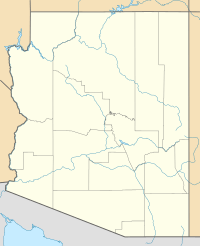San Luis Mountains facts for kids
Quick facts for kids San Luis Mountains |
|
|---|---|
| Highest point | |
| Elevation | 4,797 ft (1,462 m) |
| Geography | |
| Country | United States |
| State | Arizona |
| Region | Sonoran Desert |
| County | Pima County |
The San Luis Mountains are a small mountain range in southern Pima County, Arizona. They are very close to the border between the U.S. and Mexico, located northeast of Sasabe.
This mountain range stretches about 10 miles (16 km) from northwest to southeast. To its west, it touches the Buenos Aires National Wildlife Refuge. Both are found in the southeastern part of the Altar Valley. On the southeast side, the San Luis Mountains meet Cobre Ridge, which has several peaks. Cobre Ridge is next to the Pajarito Wilderness and the western end of the Pajarito Mountains.
The town of Arivaca is in the valley northeast of the San Luis Mountains. It is at the southeast end of the Las Guijas Mountains. Arivaca Lake is about 5 miles (8 km) upstream on Arivaca Wash. The international border is less than one mile south of the mountains in Fresnal Wash. Cumero Mountain Peak, which is 4,698 feet (1,432 m) high, is 2.1 miles (3.4 km) north of the border.
Mountain Neighbors
The San Luis Mountains are part of a group of ranges in the area. To their southwest are the San Luis Mountains themselves. To their northwest are the Cerro Colorado Mountains. These two ranges are west of a special group called the Tumacacori Highlands.
Tumacacori Highlands
The Tumacacori Highlands are made up of four mountain ranges. These are the Tumacacori, Atascosa, Pajarito, and Sierra La Esmeralda ranges. They are mostly in western Santa Cruz County.
Wild Cat Study
The Tumacacori Highlands are now part of a conservation study. This study looks at how wild cats use these mountains as a "travel corridor." The project is called Cuatros Gatos, which means "Four Cats" in Spanish. It focuses on four types of wild cats. These include mountain lions, bobcats, ocelots, and jaguars. Scientists want to understand how these animals move between different mountain areas. This helps protect their habitats and ensures they can find food and mates.
See also
 In Spanish: Sierra de San Luis (Arizona) para niños
In Spanish: Sierra de San Luis (Arizona) para niños


